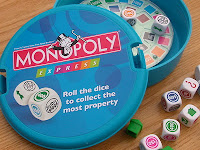I gave our good friends Sheila and Keith a copy of
Chicago Express (designer
Harry Wu, artist
Michael Menzel, publisher
Queen Games)
for a wedding gift. I had never played before, but I was looking for something suitable for two to six players - something they could play together as a couple but that our occasional "game night" group of friends could play as well.
CE came up pretty high on the boardgamegeek rankings, and the reviews looked promising, so it felt safe as a gift choice.
Sheila and Keith hosted a dinner party last night, and we got to play a six-player session. None of us had ever played before, so I read the rules beforehand. The game struck me as the perfect implementation of capitalism in game form. Railroad company shares are sold at auction. Company dividends are distributed among shareholders based on earnings. Stockholders - or board members, if you like - direct the investment of capital raised from the sale of shares to invest in railroad expansion and development to improve the company's earnings. I have never played an 18xx railroad game, but I have the impression that
CE is a kind of "18xx light."
We had a really great time with this game. I was very pleased that it was a relatively easy game for all of us to learn even though we had no one at the table who had played before. (The only open rules question for us was whether money is "hidden" or "open"; the
boardgamegeek consensus seems to be that money in any game is open unless the rules specifically provide for hiding it, as in
St. Petersburg.) I think as we played, we all overbid pretty heavily for stock certificates. More players chasing a fixed number of shares, which were the only source of income - supply and demand at its finest. We had so many auctions that three railroads had only just reached Pittsburgh when Rebecca triggered game end with an auction of the last share of the New York Central after the Pennsylvania and B&O had already sold out.
Part of what struck me about this game is a complete absence of luck. I didn't really think about it until the game was over, but there is not a single card draw, dice roll, or bag pull in the entire game. As one reviewer mentions, the only "random" element (if you can call it that) is the seating order around the table and determination of starting player. The rest of the game is determined entirely by the decisions of the players at the table. Even more than
Puerto Rico (which I consider a brilliant design),
CE is entirely in the hands of the players.
The more I think about
CE, the more excited I am about it. I've put it on my "must have" short list.
 |
| 1962 3M edition |
Rebecca mentioned that
CE reminded her of
Acquire. I have only played
Acquire once, at PrezCon, and I loved it enough to buy it on eBay, but haven't had the opportunity to play since. I had recently read mention of
Acquire when Little Metal Dog Show called it "
a stone-cold classic" in a post about ten days ago. Rebecca and I agreed that we should bring it to the table at our next opportunity. Since that conversation, I ran across an interesting
boardgamegeek thread comparing the two games. This is another game that I need to bring out soon.
So many games, so little time.






